‘A great Daily Organ’: the Freeman’s Journal, 1763–1924
Published in 18th–19th - Century History, 20th-century / Contemporary History, Features, Issue 3 (May/Jun 2006), Volume 14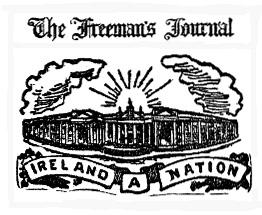 The Freeman’s Journal was published in Dublin continuously from 1763 to 1924. In its early years it was associated with the ‘patriot’ opposition in the Irish parliament—most notably Charles Lucas, Henry Grattan and Henry Flood.
The Freeman’s Journal was published in Dublin continuously from 1763 to 1924. In its early years it was associated with the ‘patriot’ opposition in the Irish parliament—most notably Charles Lucas, Henry Grattan and Henry Flood.
Lucas is generally credited with having founded the paper, though its first editor was Henry Brooke, well known as an author in the 1760s.
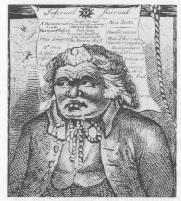
Caricature of Francis Higgins (aka the ‘Sham Squire’), editor between 1784 and 1802, when the Freeman had a dubious connection with Dublin Castle.
The Gray family, 1841–92
The Gray family’s involvement with the Freeman’s Journal spanned three generations—starting with Sir John Gray, who is best known for his work as a member of Dublin Corporation in bringing the Vartry water supply to the city, for which achievement a statue of him still stands in O’Connell Street. With a small group of associates,
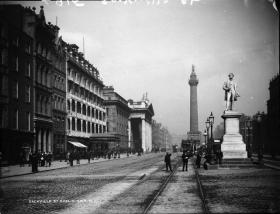
The statue of Sir John Gray in Sackville Street. He acquired the Freeman in 1841, starting a long association with the Gray family. (National Photographic Archive)
he acquired the paper from Lavelle’s widow in 1841. In 1850 he became its sole proprietor. A Protestant, John Gray—like Lavelle—supported Repeal, and later the Irish Tenant League movement and Church of Ireland disestablishment. He sat as MP for Kilkenny from 1865 until his death in 1875, and had begun to ally himself with Isaac Butt’s Home Rule party in the last year of his life.
His son, Edmund Dwyer Gray, owned the Freeman’s Journal from 1875 until 1888, and was also a Dublin city councillor and Home Rule MP. A moderate, he initially opposed Parnell and threw the weight of the Freeman—unsuccessfully—against him. When, after the 1880 general election, Parnell was elected chairman of the Irish parliamentary party, Gray was one of eighteen MPs who voted against him. Thereafter, however, he largely supported Parnell’s leadership—partly because he accepted that Parnell was now invincible, but also because in 1881 Parnell established his own paper, the weekly United Ireland, with the Freeman’s star reporter (and later MP), William O’Brien, as editor. The threat that United Ireland might, if necessary, be turned into a daily organ to rival the Freeman copper-fastened Gray’s loyalty.
O’Brien wrote of Edmund Dwyer Gray that he was ‘the most enterprising newspaperman Ireland ever produced’. Under his management, the Freeman’s production capacity was greatly expanded, its circulation increased threefold—to over 30,000 copies per day—and it became highly profitable. So successful was it that Gray eventually turned it into a public company in 1887, with share capital of £125,000, while contriving to retain control himself. The pursuit of his business interests was at least as important as politics in Gray’s life. This is reflected in a harsh assessment of him by the then lord lieutenant, Earl Spencer, in a letter to Gladstone dated 25 August 1882:
‘Gray is a man who plays a game & that a false game for he does not at heart believe in the policy of the extreme men in Irish politics [by which Spencer meant Parnell and his followers] & yet he is always pandering and flattering their policy & themselves. His sole object is to make his paper pay. I confess that I have the lowest possible opinion of him.’
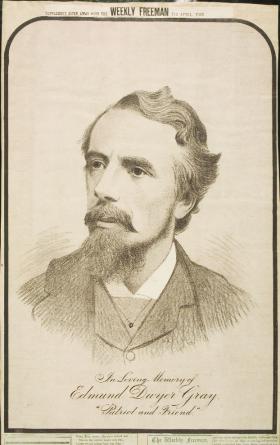
Edmund Dywer Gray took over the newspaper in 1875.
A similar judgement is suggested in Joyce’s Dubliners: in the story ‘Grace’, when one of the characters recalls Gray ‘blathering away’ at the unveiling of his father’s statue in Dublin, another comments that ‘none of the Grays was any good’.
Edmund Dwyer Gray died at the early age of 42 in 1888, having converted to Catholicism in 1877—presumably through the influence of his wife Caroline (née Chisholm), a devout, English-born Roman Catholic. She was the daughter and namesake of the English philanthropist Caroline Chisholm, celebrated for her work for female emigrants to Australia but mercilessly caricatured as Mrs Jellyby in Charles Dickens’s Bleak House. Mrs Gray was effectively in control of the Freeman at the time of the Parnell split, owning over 40 per cent of its share capital.
At the outset of the split, the Freeman—with Mrs Gray’s approval—came out strongly in favour of Parnell. However, once the anti-Parnellites launched their own daily newspaper, the National Press, in March 1891 and the Freeman began as a result to lose circulation and revenue, Mrs Gray wavered. Her son now entered the picture: also named Edmund Dwyer Gray and aged 21, he had just returned from an extended visit to Australia and was justifiably fearful for his inheritance. Under his influence, Mrs Gray resolved that the paper should switch sides. A change in the composition of the Freeman’s board was necessary to achieve this. That required a special general meeting of the company, held on 21 September 1891. The new anti-Parnell board chosen by Mrs Gray included her son and the man soon to become her second husband, Captain Maurice O’Conor, a cousin of the O’Conor Don. The Freeman and the National Press later merged in March 1892, with Mrs Gray (now Mrs O’Conor) selling her shareholding as part of the deal: in simultaneous transactions, the Freeman company bought the National Press newspaper for £36,000 and the National Press company bought Mrs Gray’s shares for exactly the same sum.
The young Edmund Dwyer Gray and Captain O’Conor both ceased to be directors of the merged company in 1893. In the following year, young Gray—now without prospects in Ireland—emigrated to Australia. He settled in Tasmania, where he became a journalist and politician of note. He was the editor successively of three newspapers in Hobart, and was elected in 1928 to the Tasmanian parliament for the Labour Party. He was treasurer and deputy premier of Tasmania from 1934 until his death in 1945, except for six months in 1939 when he served as interim premier.
Discord and decline, 1892–1919
After the merger of the Freeman and the National Press, there was a long and bitter struggle for control of the paper between rival anti-Parnell factions led by Tim Healy and John Dillon—both MPs and also directors of the merged company. Eventually it came under the control of Thomas Sexton, another prominent anti-Parnell MP, who tried to remain above the warring factions but was nevertheless more closely identified with Dillon than with Healy. A renowned orator (hence his sobriquet ‘silver-tongued Sexton’), he had been a journalist on the Nation newspaper before entering politics and was the Irish party’s acknowledged financial expert. He became chairman of the Freeman company in 1893. This proved an unhappy arrangement—at least from the Irish party’s perspective—because in 1896 Sexton, disillusioned with the continuing divisions within the party, unexpectedly retired from parliament. Afterwards, apparently regretting his loss of influence, he would use the Freeman’s Journal—where he remained chairman until 1912—to try to impose his will on his erstwhile colleagues. He was increasingly out of sympathy with them, and this was reflected in the Freeman. When Dillon complained about the paper’s attitude c. 1899, Sexton’s reply was that ‘the people had lost interest in parliamentary work’. Perhaps he was right, but the Freeman was supposed to be the organ of the anti-Parnell MPs.
Relations worsened with the reunification of the Irish party under John Redmond in 1900, and in 1903 Sexton and the Freeman were in open conflict with the party over the land purchase scheme introduced by the chief secretary, George Wyndham. Sexton denounced the financial terms as much too generous to the landlords. Again, he was probably right: the act had to be modified significantly in 1909. But why was Sexton unwilling to moderate his opposition for the sake of party unity or even to acknowledge the undoubted benefits of the scheme? He had a personal grievance: the scheme had been negotiated with a group of Irish landlords by William O’Brien MP—the former editor of United Ireland—who promised to consult Sexton about it but did not do so.
After Wyndham’s land act passed into law, John Dillon (now deputy leader of the reunited Irish party) joined Sexton and the Freeman in challenging the principle of seeking conciliation between the party and the landlords. Their concern was that ‘conciliation’ would not deliver home rule and might actually help the Conservative government achieve its avowed objective of ‘killing home rule with kindness’. On the other hand, since ‘conciliation’ had brought about the land act, O’Brien and others saw it as the basis for future progress in Irish politics. Redmond, while sympathetic to ‘conciliation’, refused to dissociate himself from those who held the opposite view. He was trying, as party leader, to avoid another split, but he did not succeed: O’Brien and Healy broke with the party because of Redmond’s equivocation, and were never in communion with it again. So the policy of ‘conciliation’ failed, destroyed—at least in part—by the Freeman’s hostility. It would probably have failed in any event, and it was the last serious attempt at cooperation between unionists and nationalists in Irish politics until the Sunningdale agreement of December 1973, itself destroyed by the Ulster Workers’ Council strike in the following May.
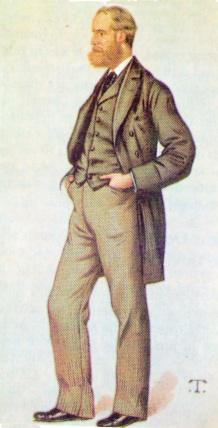
Charles Stewart Parnell—Gray initially opposed him and threw the weight of the Freeman—unsuccessfully—against him, but once Parnell had established his leadership Gray largely supported him. (Vanity Fair)
A London-based syndicate made a determined effort to acquire a substantial shareholding in the Freeman in order to change its stance on ‘conciliation’. The syndicate was led by Tipperary-born businessman Edmond J. Frewen, a close associate of Wyndham and a relation of Brendan Bracken, later Churchill’s minister for information. Sir Thomas Lipton—the ‘boating grocer’ (so described by Kaiser Wilhelm II), whose family hailed from County Monaghan—appears to have put up most of the necessary capital. Sexton frustrated the syndicate by blocking registration of the share transfers. O’Brien and Healy both became involved with the syndicate, though to what extent is unclear. That was one of the issues in a libel action taken by O’Brien against the Freeman in 1907—which he won, but he was awarded derisory damages of one farthing.
Sexton’s chairmanship of the Freeman’s Journal—from 1893 to 1912—coincided with a relentless decline in the paper’s fortunes and prestige, which had its roots in the divisions within Irish nationalism brought about by Parnell’s fall, divisions replicated in the newspaper market. First, the damage inflicted on the Freeman by the National Press had been huge: its circulation fell by a quarter in 1891 and by a further 11% in 1892, and the merger with the National Press cost it £36,000. Then, after the merger, it continued to face strong competition from the Irish Daily Independent, established as a pro-Parnell organ in 1891 after the Freeman defected to the other side, but in 1900 purchased by William Martin Murphy, an ally of Tim Healy (who had lost out to Sexton in the battle for control of the Freeman’s Journal in the early 1890s). In these circumstances the Freeman lacked the funds necessary for investment; and Sexton, afraid of losing control, would not raise new capital. Accordingly, at a time when the market for newspapers was expanding at an enormous rate, the Freeman was unable to respond to the increased demand. It is estimated that total sales of daily newspapers in Ireland grew by a factor of seven between the early 1880s and the 1920s—from 75,000 copies per day in the 1880s to over half a million in the 1920s. However, the Freeman’s daily circulation remained at 30,000–35,000 copies—approximately the level achieved under Edmund Dwyer Gray in the 1880s—and the company did not have the production capacity for much more.
William Martin Murphy seized the opportunity thus presented to him. In 1905 he transformed his paper, the Irish Daily Independent, into the modern Irish Independent, at half the price of the Freeman—a halfpenny, instead of a penny—and with a more popular format and a less partisan editorial policy. In effect, he copied what Lord Northcliffe had done in London in 1896 when he launched the Daily Mail, the first mass circulation newspaper in these islands. The new Independent was an immediate success, and its circulation would grow steadily to about 100,000 copies per day by 1915. This further weakened the Freeman, which soon began to incur heavy trading losses. Sexton hung on as chairman for some time, but in 1912 the Irish party leaders finally acted to save the paper and forced his resignation. From that point on, the Freeman was subsidised from party sources. It continued to incur losses, and its parlous condition was exacerbated by the destruction of its premises during the 1916 Rising. It was impossible for the Irish party stalwarts who then ran the paper to keep it going once the party had been defeated in the general election of December 1918. It was sold off in October 1919.
Martin Fitzgerald, 1919–24
In its final years, the Freeman was the property of Martin Fitzgerald, a prominent Dublin wine-merchant. The Fitzgerald name is still on the wall of his former premises in Westmoreland Street. Initially, Fitzgerald ran the paper in partnership with a British journalist, R. Hamilton Edwards, who had worked with Northcliffe in London before retiring to Ireland around 1914. They shared an interest in horse racing, which is presumably how they met. The year 1919 was an inauspicious one in which to attempt to revive an ailing Irish newspaper of moderate nationalist sympathies, and Fitzgerald lost a huge sum in the effort to do so. The difficulties he encountered were extraordinary:
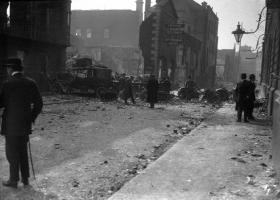
The destruction of the Freeman’s premises during the 1916 Rising exacerbated its parlous financial condition. (National Photographic Archive)
the Freeman was suppressed by the British military authorities for seven weeks from December 1919 to January 1920; Fitzgerald, Edwards and the editor, Patrick J. Hooper, were imprisoned in Mountjoy Jail for a month at Christmas 1920 following publication by the Freeman of a story of army brutality; after the Anglo-Irish Treaty of 1921, which the Freeman strongly supported, its printing presses were smashed in March 1922 by a raiding party of 200 Irregulars (as the Republican opponents of the Treaty were known); and, because of the Freeman’s stance against the Irregulars, Fitzgerald was ordered by them to quit Ireland in December 1922 on pain of death. He published a facsimile of that threat in the Freeman, but otherwise—courageously—ignored it.
Fitzgerald played a key role in the process leading up to the 1921 Treaty, though inevitably the exact details are something of a mystery. What is clear is that, once the British government decided to explore settlement possibilities, he was able, and willing, to use his standing as a newspaper proprietor to act as an intermediary between Sinn Féin and Dublin Castle. He was in regular contact with both Michael Collins and Alfred (‘Andy’) Cope, the shadowy assistant under-secretary at the Castle who conducted most of the secret British negotiations with the Irish leaders in the period before the truce in July 1921. Cope, adopting the nom de guerre ‘Mr Clements’, frequently visited Fitzgerald’s home. Confirmation of his role as a go-between is to be found in the diary of Sir Mark Sturgis, another senior Dublin Castle official. For example, on 2 July 1921—just a few days before the Truce was agreed—Sturgis wrote:
‘Went out with Andy [Cope, from the Castle] soon after 11 . . . I was then taken and introduced to Martin Fitzgerald who says the thing [that is, arranging the truce] is going splendidly. It is, said he, a big confinement, all will be well but don’t try to hurry it—he told us that there was an important meeting yesterday and will be another probably tomorrow, possibly at his place . . . He was most interesting and affable. We suggested that the release of Lord Bandon [held captive by the IRA] would look well and be a good move vis-à-vis Griffith [just released from prison at Cope’s instigation]. He scouted the idea that [Bandon] might be dead—and said he’d take it up at once but it might take a day or two.’
Lord Bandon was, in fact, released on 12 July 1921. Fitzgerald’s relationship with Cope took on a further aspect when, during the Treaty negotiations, the latter sought to influence the shapers of public opinion in Ireland to support the emerging settlement, in particular the press and the Roman Catholic hierarchy. Through Fitzgerald, Cope succeeded in exercising a measure of control over the contents of the Freeman’s Journal at that time.
The Freeman’s subsequent campaign in favour of the Treaty was generally regarded, even by many on the pro-Treaty side, as unduly partisan. It included intemperate editorials, the suppression of anti-Treaty manifestos and speeches, and a notably malevolent treatment of Erskine Childers, which culminated in a cartoon depicting de Valera as the mouthpiece of Childers. However, the new administration in Dublin came increasingly to rely on the Freeman for propaganda.
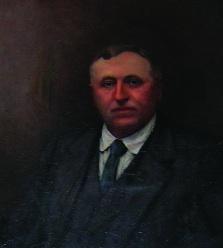
Martin Fitzgerald, a prominent Dublin wine-merchant, was the last owner of the Freeman’s Journal. (Fitzgerald family)
In recognition of this, and also because he would represent the old home rule tradition, Fitzgerald was nominated to the Free State Senate in 1922. He served in that forum until his death in March 1927. By then, the Freeman had succumbed to its many tribulations. The main cause of its demise was that the partnership of Fitzgerald and Hamilton Edwards had ended in grief when Edwards tried unsuccessfully to corner the market in newsprint and then absconded, leaving debts that the enfeebled Freeman could not meet. The last edition appeared on 19 December 1924. The Freeman’s assets, including the title, were later bought by its archrival, the Irish Independent, which for many years afterwards carried in its masthead the legend ‘incorporating the Freeman’s Journal’.
Conclusion
Thus ended the Freeman’s ‘hundred and sixty-one years of service to the Irish people’ (to quote from its valedictory editorial). It had occupied a central position in Irish public life for most of those years, and this is affirmed by the fact that the newspaper features prominently in Joyce’s Ulysses. The ‘Aeolus’ chapter in Ulysses is set in the Freeman’s offices in North Prince’s Street, and reference is made in it both to Patrick Hooper (the last editor of the Freeman, imprisoned with Fitzgerald and Edwards in 1920) and to his long-serving predecessor, William Henry Brayden, editor from 1892 to 1916. In the opening sequence of the ‘Aeolus’ chapter, Brayden’s ‘stately’ arrival in the Freeman building at about noon to begin his day’s work is observed by Leopold Bloom, who, noticing his ‘fat folds of neck’, recalls Simon Dedalus’s gibe that ‘all his brains are in the nape of his neck’.
On the other hand, the identification of the newspaper with Aeolus, the god of the winds, is a typically cruel piece of Joycean mockery. Later in Ulysses even worse was to flow from Joyce’s pen: in the ‘Circe’ chapter—set in Dublin’s nighttown—the Freeman’s title and that of its weekly edition, the Weekly Freeman, are transmogrified into the ‘Freeman’s Urinal and Weekly Arsewiper’. It is, however, gratifying to report that, when Mr Bloom visited the privy behind his home in Eccles Street, early in the morning of 16 June 1904, he did not make use of the Freeman but relied instead on the popular English magazine Tit-bits. That was one indignity that the poor old Freeman was spared.
Felix M. Larkin is a public servant in Dublin and honorary treasurer of the National Library of Ireland Society.
Further reading:
F. Callanan, T. M. Healy (Cork, 1996).
F.S.L. Lyons, John Dillon: a biography (London, 1968).
S.J. Potter (ed.), Newspapers and empire in Ireland and Britain: reporting the British empire, c. 1857–1921 (Dublin, 2004).
D. Ryan, Remembering Sion: a chronicle of storm and quiet (London, 1934).
















